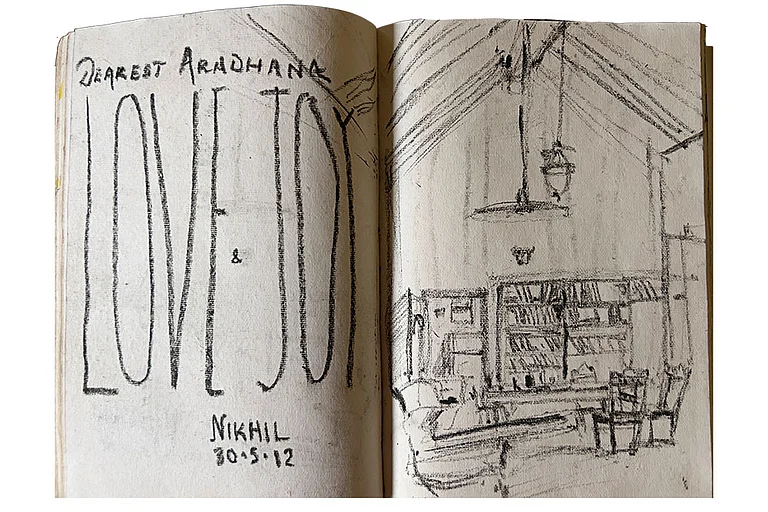The tigress Krishna, having wandered out of her territory, pushed her burly handsome head through the overgrowth, sniffing the air for a rival. Appearing tentative — perhaps nervous — she sneaked through the late monsoon green of the Ranthambore forest, evading the area’s dominant tigress being her chief concern. It was around 8 am; her movement was sly — neither sambar barks nor langoor shrieks forewarned her. To see a tigress in plain sight was like a spiritual miracle — a goddess revealing herself, a sacred and mysterious evidence of life’s vitality, its purpose and excellence.
It would not have been easy to spot Krishna were it not for Pankaj Gautam, Aman-i-Khás’s knowledgeable ranger. While other jeeps crowd near a grove of trees where she had been spotted, Gautam expertly marshalled our driver to a clearing on the atoll further up. He predicted correctly, for Krishna appeared majestically before us. For all her magnificence, there was also that fragile loneliness — the ever-looming terror of being dethroned.

***
With each visit to Ranthambore, its original, wild, unpredictable beauty deepens. While nature reserves across India offer magnificent sightings of different cats, Ranthambore has the dusty glamour of its hunting-lodge ruins, with minarets and domes, decaying alcoves and the lakes engulfing these ruins. The previous evening, the Aman-i-Khas’s butler laid tea atop Badal Mahal, a performance area situated at the northern flank of the ancient fort. In the lake before us, the spearhead outlines of crocodiles; yonder, past Padam Talao, past the date palms, a chital issued a warning cry. “It could be a leopard,” warned Virender Bhati, the gracious ‘batman’ of Aman-i-Khás. Seneca wrote that only those who made time for leisure had ever been truly alive — not so much the purposeful solitude of reading or listening to music but simply to rest one’s shoulder into life’s unfolding.
“Why don’t you go for a night drive into the village?” suggested Kishan Singh Shekhawat, the hotel’s wonderful executive assistant manager, after a sublime supper. Cords of light from the jeep skipped over the backs of darting hares; a still nilgai bathed in this light had the quality of a Robert Brook photograph — eerie, formal, mercurial. The chauffeur Ram Kishan stopped the jeep and hiked up the glass shield — I was freezing, and the shield really cut the draft. A bracing ride through the icy darkness of Sawai Madhopur was something out of a Wes Anderson film — beautiful and bizarre enough to be inaccessible, yet radiating a familiar, low-lit intimacy. With knuckles freezing, I returned to the warmth of my tent at Aman-i-Khás, a square of sumptuous white — dignified and monastic — where lay, among all essential things, an exquisite pair of night slippers. My first trip within India after 18 months — I felt lucky to spend these days among the birds and wildcats of Ranthambore, and at the Aman, which has come to define luxury as a kind of daily exhalation of kindness. Motoring down the next morning to Amanbagh, a sister property three hours away, the chauffeur Jagdish Singh slowed the car each time I took a sip of water from my flask. After the horrors of the past months, such acts of grace have the whiff of a miracle.

***
To arrive at Ranthambore, I had landed in Jaipur, where I met with the brilliant Mita Kapur, author and director of the JCB Book Prize. Over dinner at Rambagh Palace’s magnificent Suvarna Mahal, we discussed the changing face of her hometown. Stores like Nila — masterfully designed by Bijoy Jain — were a glimmering new cultural locus, while older spaces like IDLI, whose brocade jackets had the loaded fusillade of a Takashi Murakami painting, had shuttered in the pandemic. Chef Sunil Sharma was, however, working at the height of his powers: the laal maans at supper was museum-grade.

“It’s great to see Jaipur’s design culture draw so many talented people from all over the world,” Mita remarked. In our conversation, the sweet lilt of meeting again as well as the shock of meeting alive surfaced. Over a remarkable, soul-elevating dessert of rose ice-cream, Mita and I locked eyes briefly, perhaps in glad incredulity that there was still the respite of friendship — this waltz in a minefield.“I’m so happy to see you,” she said, as we parted company. “Come back soon.” So many months had passed, but I hadn’t felt so free in a long spell.

***
A beehive accidentally fell on Ritesh Mudgal, Amanbagh’s thoughtful assistant general manager, as he was overseeing the construction of an ayurvedic apothecary. Mudgal’s face was unruffled as he recounted this story, but I could imagine the absolute, shrieking terror of being covered by stinging bees. “I felt lucky to survive,” he admitted, smiling. The apothecary — or the ayu-shala — was a dream of Dr. Anoop, who, after working for years in south Goa, arrived in Rajasthan’s Ajabgarh valley to head Amanbagh’s fine spa. I stayed on the grounds to consult with the good doctor, a repository of counsel and insight. “I hope, one day, we can prepare healing tonics here for our guests,” he said, walking me through a carefully tilled herbal garden with its pronounced aroma of neem. The resort had given Dr. Anoop the space and resources to follow a vision. The result was a special space — sanctuary-like, in its infancy when I saw it, but whose future I would track.
Flanked by the Aravalli and Bhangarh Fort, Amanbagh’s location is unique — like a red stone flower, it blooms in the Ajabgarh basin. The architect — the late great Ed Tuttle — has created an oasis of intermingling serenities, small pale-red villas with private pools and clusters of pavilion rooms. There are long, regal paths to stroll on, where the shadows in your path are of palm and eucalyptus trees, while the estate’s sprawling lawns summon to mind the detailed perfections of a miniature painting.

On my last night, Mudgal planned a surprise off-site dinner, under an abandoned chatri in the velvet darkness of the countryside — an enchanted setting with a warm sigri at my feet, and a musician singing softly, in earnest. “It is the perfect venue for honeymoon couples,” the server said to me helpfully. I felt a bit chastened about arriving alone, but it was just as well. I looked up — the sky was pitch dark, as if coat after coat of black had been splashed over it, blurring the memory of any other colour — the saffron of dusk, the milky violet of daybreak — with stars hammered into the sky. Here it was, all along — the night in shining armour.





















